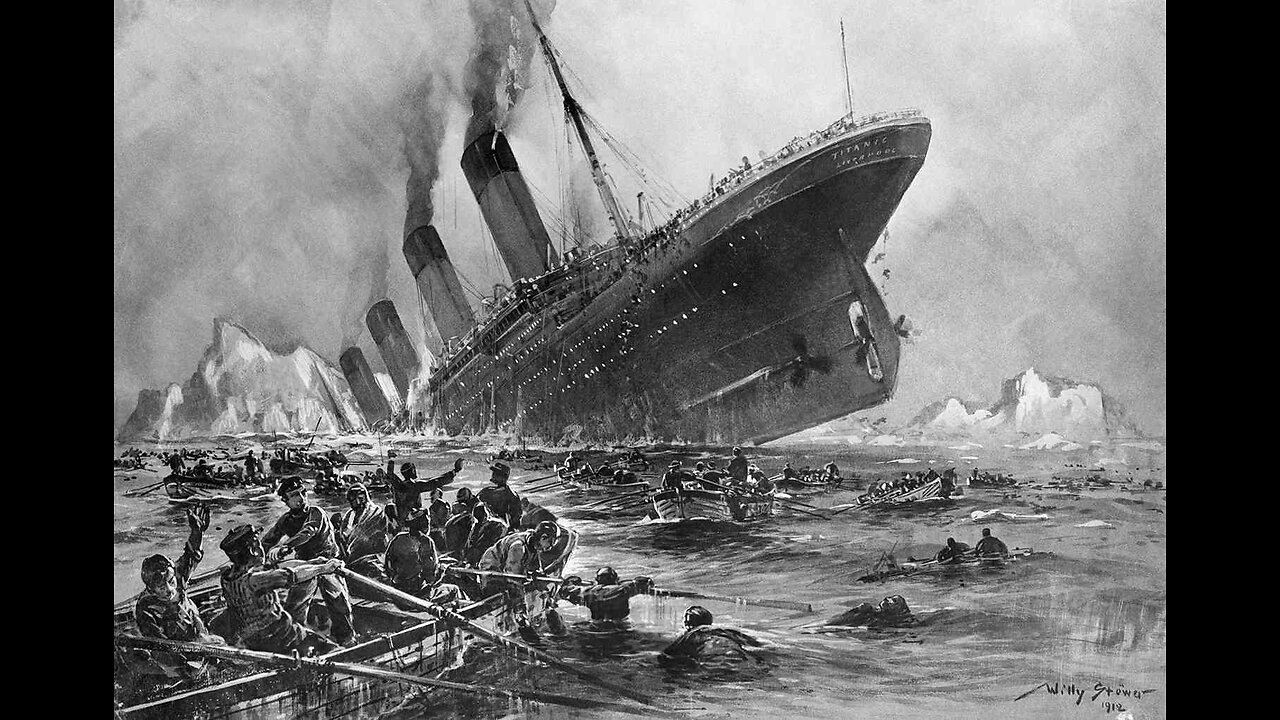Premium Only Content

How the Titanic Sunk
An overview to how the titanic sunk and the key events that occurred before, during and after the disaster.
1912 saw the sinking of the Titanic.
Construction of the extravagant British passenger liner RMS Titanic began on March 31st, 1909, in Belfast, Ireland's Harland & Wolff shipyard and was finished in 1912, three years later. It was designed to be the largest luxury passenger ship in the world and would cost 7.5 million dollars to construct. It was one of three Olympic-class Ocean liners. It was 46,328 tonnes in weight and measured 882 feet, 9 inches (or 269.1 metres) in length, 175 feet (53.3 metres) in height, and 92 feet, 6 inches (or 28 metres) in width. The cargo decks and the tank top, which housed the engines, boilers, turbines, and electrical generators, were below the waterline. The bridge, wheelhouse, and lifeboats were located on the boat deck, which was the highest point. The passenger decks with first-, second-, and third-class seats were located in between. Second class on this ship was similar to first class on any other ship due to the extreme level of luxury. The 2,240 passengers would come from various socioeconomic backgrounds, including millionaires, celebrities, and low-income immigrants seeking a better life in America. A grand staircase that allowed first-class passengers to travel between decks and a dome skylight that let in natural light allowed the ship to function like a floating hotel. The ship also had a squash court, Turkish bath, reading room, barbershop, gymnasium, dining saloons, and swimming pool. Out of a possible 64 lifeboats, the ship only carried 20. There weren't enough for the entire crew of the ship. This was permitted by law, though, as lifeboats were only meant to take people to rescue ships that would be nearby, not to keep the entire ship population afloat. Because of this, White Star Line, the business that owned the Titanic, was complacent enough to keep the number of lifeboats low in order to keep the deck uncluttered. Because the Titanic's hull was separated into 16 watertight compartments, many people believed the ship could not sink. Up to four of these, according to legend, might flood without sinking the ship. All of these features prompted media coverage of the new passenger liner to increase. In Southampton, England, on the morning of April 10, 1912, passengers started to board the Titanic as vast crowds gathered to witness the ship leave. The Titanic began her maiden trip at midday under the direction of Captain Edward Smith. It would make additional passenger pickup stops in Cherbourg, France, and Queenstown, Ireland, before continuing on its journey across the North Atlantic Ocean to New York City. On April 14th, 1912, reports of icebergs from other lines prompted Captain Smith to calculate a new path while according to customary procedure—continuing to steam at full speed. It was getting dark, the temperature was dropping below freezing, and there was no moonlight or waves to help them notice the icebergs coming their way. Frederick Fleet, the ship's lookout, noticed an iceberg from the crow's nest around 11:40 p.m. ship time. Iceberg! Right ahead, he yelled as he rang the alarm bell and called the ship's bridge officers. Due to the crow's nest binoculars being locked away, Fleet had only been able to see the iceberg with his eyes. The Titanic scraped the iceberg down its side, ripping multiple holes in its hull below the waterline, with pieces of ice striking the deck. The officers on the bridge rapidly manoeuvred the ship away from the iceberg, but it was too late. Everyone initially felt relieved because the crash, which happened at 11:50 p.m., was not even felt by the lookouts or the passengers. Thomas Andrews, the ship's architect, and Captain Smith went to assess the damage. They were aware that the ship would soon begin to sink because six of its watertight compartments had already been ruptured and were starting to flood. The Titanic's passengers were instructed to enter the lifeboats after the captains issued a distress call over the radio in the hopes that other ships were in the area. He was aware that there would barely be enough lifeboats for half of the Titanic's passengers. Women and children were loaded into the lifeboats first as per marine policy. Confusion and disarray caused only 28 women and children to board the first lifeboat to depart although it could have held 65 people. Many passengers were still confused about what was happening. While second officer Lightoller saw the order to mean exclusively women and children, first officer Murdoch understood it to mean women and children first, followed by men if any were present. When the Titanic's distress signal was picked up by the Carpathia, which was 58 miles away, she set out to save the people. To aid in finding the Titanic, which was sinking, flares were fired into the sky. By one in the morning, the lower decks were flooded, and the ship's bow started to fall beneath the water. Because the passengers had left their portholes open, water was coming in 15 times quicker than it could be pumped out. The stern was unsupported, and its propellers soared into the air and out of the water. As the number of lifeboats decreased, confusion and panic ensued. Many passengers did not want to escape the accident and be labelled a coward back home, so many chose to stay behind or gave up their seats to more vulnerable passengers. Some people forced their way to the lifeboats, while others accepted their fate and stayed behind. 1,500 people were still aboard the ship at 2:05 a.m. after the last lifeboat had left. Many guests fell into the freezing, dark waters because the deck was suddenly at a sharp height. At 2:17 a.m. The captain declared that each man was on his own. Under the strain, the stern buckled and split off, with the front half sunk to the ocean floor. At some point captain Smith went down with the ship a maritime tradition in accepting responsibility for all on board. Some claim he went to the wheelhouse and waited for death, while others claim he shot himself. The Titanic submerged almost four kilometres beneath the ocean's surface as the stern filled with water. While many people drowned, the main cause of death in the icy waters was hypothermia, which struck within minutes of exposure. Only four survivors were discovered despite some lifeboats making a repeat trip to the area. At 4:10 a.m., the Carpathia arrived on the scene and took the lifeboats. Over 1,500 people would die in the accident, with only 705 passengers surviving.
-
 LIVE
LIVE
The Jimmy Dore Show
49 minutes agoTrump Tariffs Working As Planned? Trump Open to Raising Taxes on the Rich! w/ Stephen Gardner
6,606 watching -
 DVR
DVR
Kim Iversen
3 hours agoEpstein Victim DEAD at 41, Ruled Suicide. Suspicious? | The Left DOUBLES DOWN on Extremism
34.8K16 -
 LIVE
LIVE
vivafrei
9 hours agoLive with Myron Gaines - from Global Politics to the "Manosphere" & Everything in Between
6,625 watching -
 LIVE
LIVE
Rebel News
4 days ago $2.06 earnedELECTION NIGHT LIVE: Rebel News Canada coverage with Ezra Levant, Sheila Gunn Reid & Special Guests
1,975 watching -
 1:28:38
1:28:38
Redacted News
2 hours agoEUROPE'S BLACKOUT CRISIS "Nothing works!" & Israel's Silent War vs Iran just got worse | Redacted
66.9K72 -
 1:07:19
1:07:19
Candace Show Podcast
2 hours agoFarewell Show: LIVE With Ian Carroll | Candace Ep 183
55.6K61 -
 33:37
33:37
Kimberly Guilfoyle
6 hours agoThe First 100 Days: Interview with Bienvenido President Abraham Enriquez | Ep217
44K7 -
 42:58
42:58
Stephen Gardner
2 hours ago🔥BOOM! Trump's NEW EO just changed EVERYTHING!!
27.6K17 -
 LIVE
LIVE
Dr Disrespect
7 hours ago🔴LIVE - DR DISRESPECT - TRIPLE THREAT CHALLENGE - WZ, PUBG, FORTNITE
3,072 watching -
 2:12:54
2:12:54
The Quartering
5 hours agoAdam Schiff IN TROUBLE, Woke Lefties MELTDOWN Over Temu, Karmelo Anthony Family LIES, & Much More
136K43